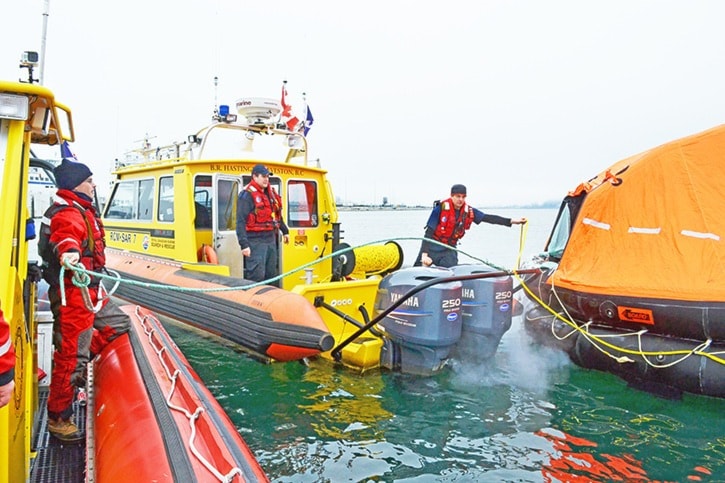Fog that shrouded Boundary Bay Monday was so thick, a search and rescue crew navigating back to Crescent Marina from a training exercise at the BC Ferries terminal had no choice but to rely on radar and GPS equipment to get there.
"It's probably the thickest fog you'll see in this bay," said Morgan Brewster, crew chief of the four-man Royal Canadian Marine Search and Rescue 5 (RCM-SAR 5) team aboard the Vigilant rescue vessel that day.
"It's worse than night because you can't (even) see lights – and I love it."
The weather condition was the worst of its kind that Brewster, coxswain Tim Murphy, helmsman Ben Jones and crew Randy Hay had seen on the water, and one they hoped recreational boaters would know better than to risk setting out in – similar conditions on the weekend led the crew to assist a 38-foot Bayliner after it ran aground.
Monday afternoon, markers that line the narrow channel leading to the marina were essentially invisible; even seabirds flying just a few feet from the rigid-hull inflatable appeared almost ghostlike.
"Ok, stay that course," Brewster advised Jones several times along the way, after directing shifts in co-ordinates and speed.
Fortunately, the skies were clear closer to the ferry terminal, where the crew had earlier joined up with teams from Delta (RCM-SAR 8) and Steveston (RCM-SAR 7) for a BC Ferries-organized exercise that gave the volunteers a chance to test how things would unfold in the event of an emergency on one of the ships.
Involving the RCM-SAR teams was co-ordinated by Carl Linton, a BC Ferries deckhand and quartermaster who also serves as the Delta squad's training officer.
"My main goal was just to kind of initiate co-operation between BC Ferries and RCM-SAR," said Linton. "It just gave all the crews a chance to kind of see how the evacuation systems on the ship sort of work, in a nutshell.
"It was kind of a door-opener."
While the action wasn't intense, it was an opportunity worth taking, said Brewster, a White Rock resident and Ministry of Finance fraud investigator. Any chance to further search-and-rescue skills – particularly in conjunction with other auxiliary marine units – is invaluable, he said.
It was also a good chance to learn about BC Ferries' procedures, Brewster said.
"What they do, what to expect when we get there."
At the same time, "I hope we never have to see this in real life."
Murphy noted the crews never rush into a rescue situation. For the safety of everyone involved – the rescue team and victims alike – Stop, Assess, Plan is one of the auxiliary's most important rules, particularly when approaching an unknown and potentially dangerous scene.
Monday, as Spirit of B.C. crew members watched from a deck high above, and RCM-SAR teams took position on the water below, the ship's captain announced the distress call.
The rescue chute and life rafts were deployed, and the auxiliary crews hooked up to and towed the circular inflatables – a shape and weight they don't encounter on a regular basis.
Calls to help stranded kite surfers and missing or distressed recreational vessels are more the norm in the waters of Semiahmoo and Boundary bays.
If Monday's exercise had been a real-life scenario, the rafts could have been carrying as many as 50 ferry passengers; weight that would have changed the dynamic of the tow.
At the helm, Jones said, even empty, the difference in the degree of control he had over the raft as it shifted from behind the Vigilant to one side was marked, from good to limited.
A member of the auxiliary crew for a little more than six years, Jones's previous boating experience includes four years in the Bahamas working for the Disney Cruise Line.
He and Murphy now both work with South Surrey's MPB Construction Ltd. Hay, with about 18 months experience on the RCM-SAR 5 crew, is an accountant.
All of the RCM-SAR 5 volunteers – there are currently 20 active – are on call for one week of every month, and training aboard the Vigilant is a regular part of the commitment.
Monday's joint training was likely one of the last that the Vigilant will see, however.
A deal to replace the aging craft – which has carried the crew for more than 12 years now – was signed last May, and construction got underway in July.
The new rescue vessel is expected to arrive early this spring, said Murphy, and will feature such upgrades as updated technology and shocks.
Fundraising to purchase the vessel began about five years ago, and while that goal – about $320,000 – has been met, once the tab has been paid the local crew will be "strapped" financially, Murphy said.
Funds for equipment and crew safety gear is all raised in the community, through private and corporate donations, legacies and sponsorships. Some funds hail from B.C. gaming proceeds; the team also hosts annual golf tournaments and a dance to help boost the coffers.
For more information, visit www.rcmsar5.com
